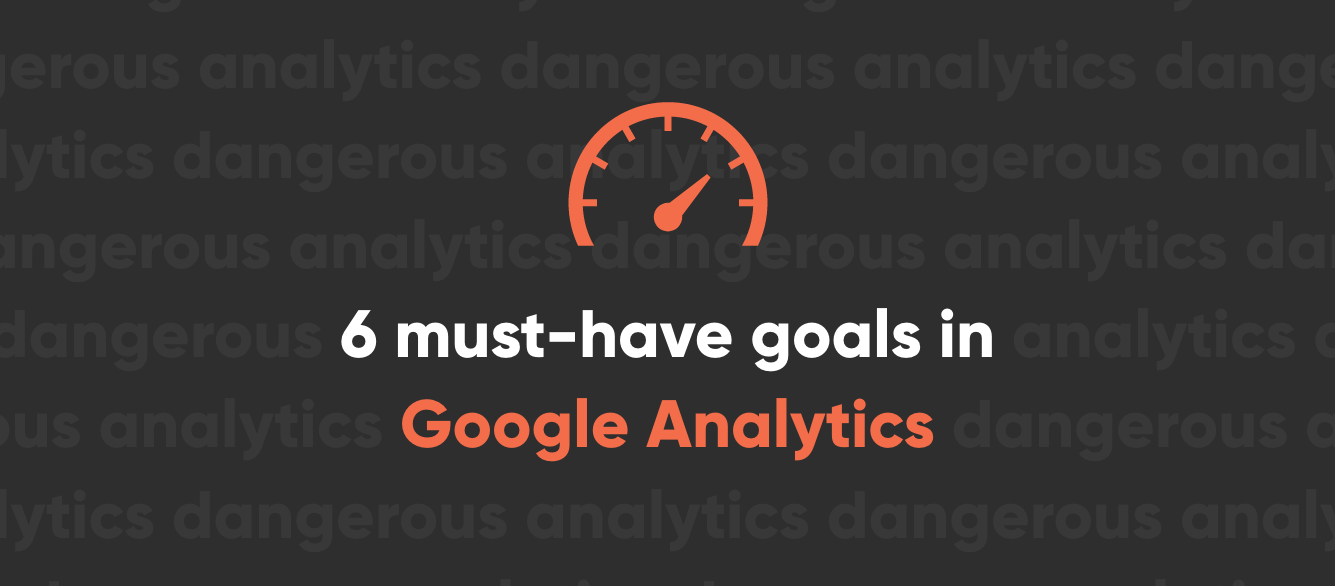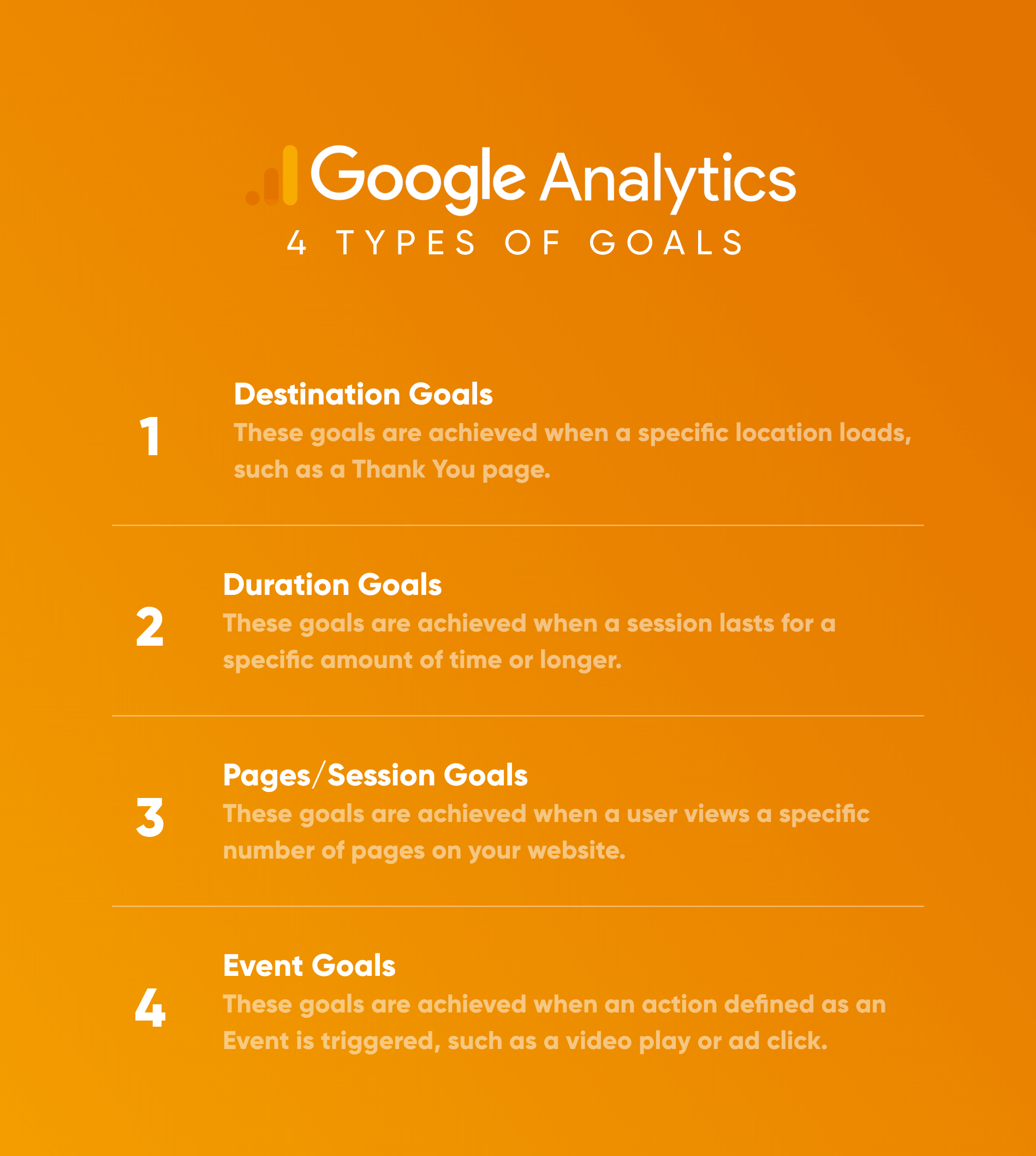
6 must-have goals in Google Analytics

Goals are important. Not only do they provide a purpose for the hard work we put in day in and day out, but they also afford us the thrill of achievement when a goal is realized and brought to fruition.
This is especially true for businesses, where goals truly help to define strategy and the best way forward in a given month, quarter, or year. And as important as setting clear and ambitious goals is, establishing ways to thoroughly track the progress against those goals is just as critical.
This is where goals in Google Analytics come in. By setting up well-thought-out goals in GA that correspond to the overarching goals of your business, you can closely monitor your progress and make adjustments as needed based on tangible, real-time data.
Here’s a closer look at what Google Analytics goals are, why they’re important, and six goals to set up to track the effectiveness of your digital marketing efforts.
What is a goal in Google Analytics?
A goal in Google Analytics measures how often users complete specific actions on your website, representing a completed activity (or conversion) that contributes to the success of your business (e.g., making a purchase from your online store or submitting a contact form).
There are four types of goals in Google Analytics. They are:
- Destination goals, which are achieved when a specific location loads, such as a Thank You page.
- Duration goals, which are achieved when a session lasts for a specific amount of time or longer, such as a user visiting your site for 10 minutes or more.
- Pages per session goals, which are achieved when a user views a specific number of pages on your website.
- Event goals, which are achieved when an action defined as an Event is triggered, such as a social recommendation, video play, or ad click.

Goals vs. KPIs
Before you can determine which goals to set up and how to go about doing so, you should first determine your website’s key performance indicators (KPIs), which should also tie closely to the goals of your business. KPIs – much like goals in GA – are quantifiable measures used to evaluate the success of your website.
Let’s say you had a goal to generate 150 quote requests through your website in a given quarter. By setting up a goal that tracks quote form submissions through the website, you can see how on- or off-track you are throughout the quarter and can also take steps to optimize user experience in the hopes of generating increased form submissions.
Why are goals important?
We already talked about why goals are important in general (provision of purpose and the sense of achievement), but setting up goals in GA is important for different reasons. Without goals, it is almost impossible to evaluate the effectiveness of your digital marketing efforts.
Having properly configured goals allows GA to provide you with critical information. It helps track your progress toward KPIs, helps you stay on top of the volume and source of conversions, and can identify areas for improvement within the user experience or conversion path.
Let’s say you have a goal set up to track the number of downloads from a given page, but that page receives minimal traffic in comparison to many of the other pages on your site. The performance (or lack thereof) against the goal might prompt you to move the downloadable link to a more prominent and higher-traffic page, thus increasing downloads toward achieving your goal.
Here’s a look at the six goals to have in Google Analytics.
1. Email click (Event goal)
By setting up a tag/trigger in Google Tag Manager (GTM) and a goal in GA, you can track when a user clicks on a clickable email address within your website to send you an email. You can also track which page they were on when they clicked, which can provide additional insight into which pages are getting email conversions and which aren’t. This can help you optimize performance by either prioritizing high-converting pages or by taking steps to improve the content and conversion rate of underperforming pages.
2. Phone call click (Event goal)
Similar to the email goal, setting up a tag/trigger in GTM and a goal in GA will allow you to track when a user clicks on a clickable phone number on your site. This can also be used to determine which pages are generating calls and which pages could use a tune-up in order to help meet your conversion goals.
3. Contact form (Event or Destination goal)
There are two ways goals can be used to track contact form submissions. The first is by setting up a tag/trigger in GTM that corresponds to the “submit form” button (i.e., the goal is completed when the user clicks to submit the form). The second and recommended way is to create a Thank You page the user is directed to upon submitting the form. This method would be classified as a Destination goal in GA, with the destination being the Thank You page.
The main reason the latter method is preferred is because in most cases it provides a clearer and more streamlined user experience. When the user arrives at the Thank You page, they know they successfully submitted the form. This is also easy to set up as a Destination goal, making it a win-win for you and your users.
4. Other forms (Event or Destination goal)
Contact forms aren’t the only types of forms that can be used to track goals in GA. We also have quote request forms, parts request forms, and many other types you may want users to fill out. These forms can also be tracked with either an Event or a Destination goal to monitor progress against your target objectives.
5. Downloads (Event or Destination goal)
Downloadable content – and especially gated downloadable content – can be a great way to generate leads and provide your audience with higher-quality, in-depth content. In GA, goals can be used to track which pieces of downloadable content users are downloading based on both the title of the file and the location of the click.
6. Newsletter signup (Event or Destination goal)
Newsletter signups are also a great way to gauge the growth of your following on an ongoing basis. As with form submissions and downloads, the goal can be set up to track either clicks on a submission button or arrivals at a Thank You or Confirmation page.
Set and achieve ambitious goals with Perrill
Since our conception as Minneapolis’s first digital agency in 1993, Perrill has grown into one of the most experienced and capable SEO experts in the Midwest. We use sustainable strategies, high-value keywords, and proven tactics to position you at the top of search results and make sure you say there.






